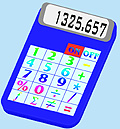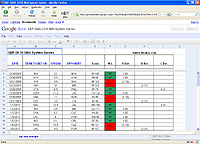 The Math
The Math

It’s said that players are in the gambling business and casinos are in the math business. I propose that you should learn and understand the math behind the bets you make so that you are a knowledgeable player and not a gambling player.
The principle I’m about to explain to you is the very reason that casinos and sports books are in business. It’s of tantamount importance and you must fully come to grips with it because this statement is the adversary you must overcome in order to be a successful sports investor.
Are you ready?…
When you win a bet in a casino you only win PART of the bet but when the house wins that same bet you lose the ENTIRE bet.
Sounds rather simple but again this is what you’re up against. Whether it’s on a table game, a gaming machine or the sports bet the house has a built in advantage that represents their profit and the reason they can keep the doors open and the lights on.
In a sports bet if you make a straight bet on either a side or a total you must LAY 11 to win 10. That is for every $10 you want to win you must risk $11. If you win the bet you get your original wager of $11 PLUS your $10 in winnings for a total of $21 (see you only won PART of the bet) but if you lose the wager, the casino keeps the entire $11 bet (you’ve lost the ENTIRE bet).
When you bet basketball or football you will be laying 11 to win 10. However in baseball and hockey you will play the money line. The reason a money line is used rather than the flat 11 to 10 is because not all teams in hockey or baseball have the same chance of winning.
So this works out to the fact that if you want to break even with flat betting you need to win ELEVEN out of TWENTY-ONE games or 52.38% of all the games you bet on.
This breaks down to a casino advantage of 4.54%. So you may be wondering why is that some casino table games with a much lower house edge are unbeatable and sports betting is not? After all the don’t pass line in craps only has a house edge of 1.402% and playing the bank in baccarat only favors the house by 1.16%.
The answer lies in the fact that the oddsmaker’s line is an opinion and NOT a mathematical certainty like cards, dice or the roulette wheel. Also because betting on sports is a “no-ante game”. That is you can choose to bet when you have an advantage.

OK, so we now know that we are going to have to win 52.38% of our games in order to be profitable. Did you know that over many trials you can flip a coin and with a mathematical certainty attain 50%. So if you just flip a coin and bet A LOT of games you can expect to win roughly half of them just by shear dumb luck. Probability theory tells us that the more trials you have it becomes a mathematical certainty that you will get closer to that 50% mark each time.
With knowledge, discipline, proper bankroll management and the right tools it’s VERY possible to obtain that extra 2.38% to be on the plus side and even an extra 3%-7% to be a significantly profitable.
As an example let’s say that your total bankroll is $1,000 (it could be more or less). If you were to just wager 5% of your bankroll, or $50 in this example, on any given game you would need to win 20 units back in order to double your bankroll (approximately 22 more wins than losses).
Going further with our example when you bet $50 on a basketball game and won you would get back your original $50 wager and $45.45 in winnings (remember you have to LAY 11 to win 10). If the bet lost you would lose the entire $50.
Each day you bet on 4 games putting at risk $200 (four times your $50 per game wager). Each month let’s say this added up to 120 total games. If you were to win 55% of the games this would be 66 winners and 54 losers. With our example you would have $2,999.70 in winnings (66 games times $45.45) and you would lose $2,700.00 (54 games times $50.00). This would leave you a profit of $299.70 for the month. When compared to your original bankroll of $1,000.00 you have just earned 29.97% on your money. And that’s not for a year that’s just for a single month!
But let’s say you just won a measly 53% of your games. You’d win 64 games and lose 57, winning $2,908.80 and losing $2,850.00 for a net profit of $58.80 or 5.88%. Again this is PER MONTH and NOT per year. Not many financial vehicles can give you 70+% profit each year and that’s just for winning 53% of your games.
With the two programs I recommend you have the opportunity to do much, much better.




